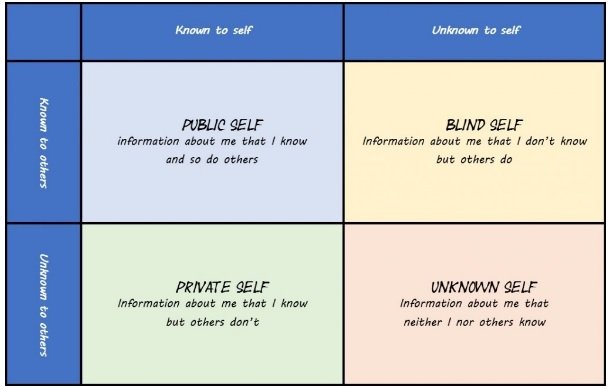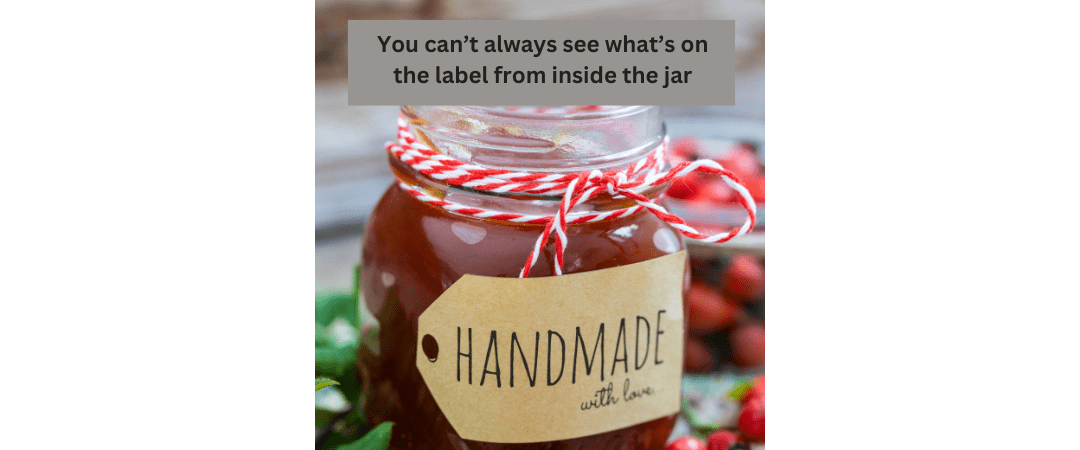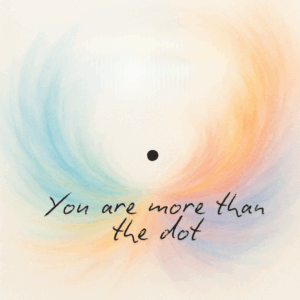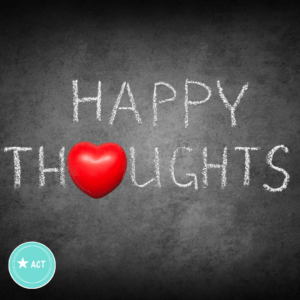You can’t always see the front of the label from within the jar!
Anon
Why sometimes we need help to see our potential
I love that quote as it so playfully communicates that we all have blind spots. The jar in this context is our minds and what’s hidden on the label is our “Potential”. Our potential, or aspects of it are can be hidden from us.
It tells us that we don’t always have all the information to help us move beyond our problems or access our potential. Sometimes there is a blind spot in our awareness. That blind spot stops us from taking the necessary actions in our lives.
Because of those blind spots, we may remain stuck or spend time scratching our heads wondering what to do. We may even take action, unaware of the danger that action can cause us. The classic example of a blind is the one we have in a car. You know the blind spot that is on the drivers side, in the area by the rear wheel. In the car even though we check for danger, using the rear view mirror and the wing mirrors, there is a spot that those two mirror just don’t see. Its a spot where a speeding car may be present but we just can’t see it.
Likewise we may have a friend or family member that is struggling with life’s challenges. Lost in the emotion of what is happening to them they just can’t find their way out of the dilemma, they have a blind spot to the solution. And yet you as a dispassionate observer can so clearly see what is going on for them. You may even be able to guide them out of their troubles if they just asked for help.
Awareness of the blind spots
Now the trouble of blind spots is that they are exactly that, they are blind, we don’t know know what is in them. The content of those blinds spots are in the unconscious. Often the blind spots exist because we have developed a habit of only seeing things from one perspective (see the blog on the Three Keys of Wisdom ). Blind spots show themselves indirectly through:
- Stuck-ness
- Procrastination.
- Anxiety, anger, depression, fear.
- Unhelpful habits (drinking too much, eating too much)
- OCD, Phobia.
- And many more unhelpful feelings, thoughts and behaviours.
The GOOD News about blinds spots is that we know that they exist, either theoretically or through the above symptoms. In other words we are not blind to the blind spots.
Since we know of them we can do something about them, so that they no longer impact us. In the case of the car analogy we can do the following:
- We can look over our shoulders to see if anything is coming when we are making a manoeuvre.
- Or signal, if pulling out into another lane, in plenty of time so that other motorists can be aware and warned.
- Or we can apply a small additional mirror in one of the corners of the car’s wing mirror so that we can see the blind spots.
The other GOOD News is that everyone has blinds spots, its part of being human and part of our growth. That is why even highly successful people have coaches, mentors and therapists. These skilled individuals (e.g. therapists, coaches) act as that mirror to make those areas visible, helping their clients address them so that they no longer have an impact.
Types of Blind spots
This is a useful explanation of our blind spots and it comes from an article written by my colleague Mel Richens (the other member of the ACT Family). It describe Johari’s window.

The Public Self:
This is what you and others see in you. You typically do not mind discussing with others this part of you. Most of the time you agree with this view you have and others have of you. You might refer to it as your comfort zone – there are no surprises here.
The Private or Hidden Self
This is what you see in yourself but you don’t want others to see. There are often parts of ourselves that are too private to share with others. We hide these away and refuse to discuss them. This may be due to feelings of embarrassment or shame. There is fear attached to disclosing these parts – if we were to do so we would be vulnerable in some way. There may also be skills and talents hidden here that we don’t want to advertise to the world due to modesty, or fear of attack.
The Blind Self
This is what you do not see in yourself but others see in you. You might think you are an open minded person, but people around you may consider you to be impatient and intolerant. On the other hand, you might see yourself as a failure, while others might see you as a success. Sometimes those around you might not tell you what they see because they are scared of your reaction, fear offending you, or might consider it a waste of time.
The Undiscovered or Unknown Self
This is the self that you cannot see nor can others around you. These are the real unknowns. Your future hopes and aspirations will be in this area.
The Journey
Therapy, coaching and mentoring recover the resources and capabilities from the “undiscovered or unknown self”. See the diagram below. In a confidential environment and within a therapeutic alliance (i.e. when the therapist and client are working together towards the same goal) the unknown areas, i.e. private self and blind self, are disclosed and fed back resulting in the “unknown self” diminishing. The comfort zone increases and so we gain more resilience, access confidence and optimism and access our innate capabilities.
Disclosure and fed back are achieved differently in different therapies. The therapies could be anything from counselling, coaching, hypnotherapy (regression, solution focused), gestalt, cognitive behavioural therapy, neuro-linguistic programming, transactional analysis, mindfulness and much much more.
Note: The expansion of the comfort zone is an on going process.

How does Solution Focused Hypnotherapy support
Simply put the Johari blind spots are considered, in SFHT, to be due to our attachment to the fight, flight, freeze primitive mind. When we are attached to the primitive mind we are fearful to share and receive feedback and so remain stuck.
When we develop access to the intellectual mind, through SFHT, we are more confident, relaxed and more able to take action to address issues as well as reach out for feedback. Feedback is something we actively want rather than a necessary evil.
SFHT supports the expansion of the client’s comfort zone by:
- Developing a therapeutic alliance between therapist and client. This produces a safe, confidential environment.
- Helping the client develop resilience, confidence and optimism. These are an antidote to fear, shame, embarrassment.
- The client empties their stress bucket through relaxation (via hypnosis) and developing agency by taking small positive actions, interacting positively and thinking positively. This raises their serotonin levels and gives them a sense of wellbeing, security and confidence and access to the resources of the intellectual mind.
- Clients are encourage to notice what is good in their lives and what is working well. This helps them develop a balanced mindset and move away from the absolute negative thinking of the primitive mind. Once again this raises the level of the wellbeing neurotransmitter serotonin.
- Positive suggestions around confidence (via hypnosis), as well as focusing on what the client wants rather than what they don’t want increases optimism and willingness to take action.
- The therapist feeds back all the positive things that they see in the client, things the client may not see for themselves.
- Plus a lot lot more 😊
See the presentation in the Free Resources for more on the SFHT process.
What next
If you want to find out more about change, how the mind works and how we create resistances such as anxiety, depression, anger, contact me at ACT Hypnotherapy for your FREE no obligation consultation. During the consultation you will learn what to do about those limiting emotions as well as how to resolve any blind spots.
Accreditation:National Council of Hypnotherapy (NCH), Association of Solution Focused Hypnotherapy (AfSFH), Association of Neuro-linguistic Programmers (ANLP)





